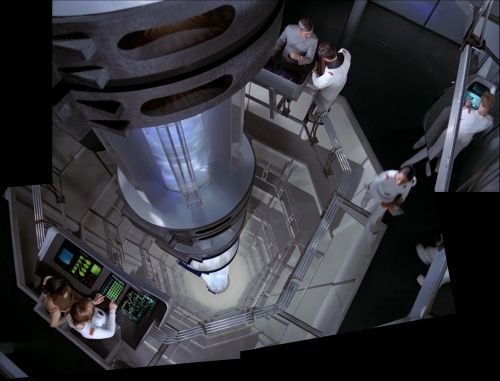I have started this thread to further explore the use of forced perspective sets & backdrops without derailing Blssdwlf's original thread, which was doing a "Thermian" approach to the Enterprise - basically, how can we fit the sets as seen on screen into our favourite ship? Complicating the issue is the presence of forced perspective sets featured in both TOS & TMP in order to make the Engine Room spaces seem larger. TMP also used painted backdrops in an attempt to make the corridor network seem more expansive. The results were...mixed, at best. How seriously can we take them?
FP has been used in film making for decades, in everything from The Time Tunnel to Willy Wonka. It was used in the Star Trek pilot "The Cage" of course (Talosian corridor), but more famously in the main series run as the "cathedral tubes" in TOS Engineering. Thanks to FP, in our first visit to the Engine Room we were treated to the depiction of a huge, long piece of equipment behind protective mesh and it looked pretty realistic.

Forced perspective sets are built with one end tapering from the other, to give the impression of distance. Being physical objects they pick up lighting the same as a normal set (or differently if required, as was often done with the Engine Room), and the actors can even interact with the set if they need to (a deleted scene in The Cage used children at the far end of the corridor). However, the illusion only really works from one or two different viewpoints, limiting the Director's creativity for blocking a shot. Before long the directors began freeing themselves from the restrictive camera angles that were imposed on them by FP and we ended up seeing the tube structure as it really was - drama always trumps realism in the industry.
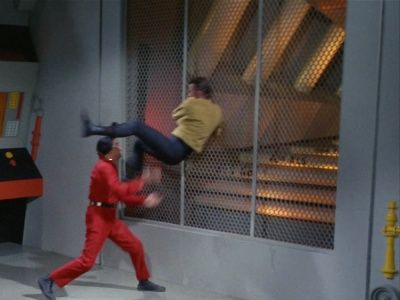
FP was used agin for the Engine Room in TMP and works pretty well, with child-actors standing in for adults at the far end.
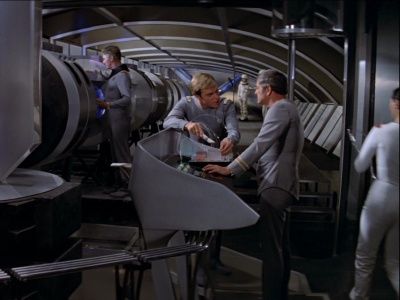
Only one camera angle was really used, which helped carry the illusion. The vertical isolation door in TWOK was added by Nicholas Meyer to block off the FP set and free up his camera angles However, in the process of filming the scene the tapered walls and walkway were revealed, along with the shortened sections of the intermix tube. Still, it is a great scene (again, drama takes precedence over technical inconsistencies).
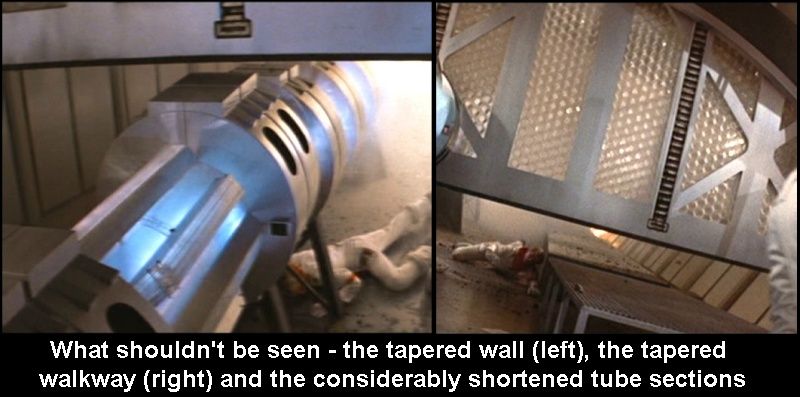
As far as I know, painted backdrops were not used in TOS (although matte paintings certainly were). However, they too have a long history in stage & film and Robert Wise seemed perfectly happy to include them in TMP. As mentioned above, they were used as corridor extenders throughout the ship, even when it seemed impossible!
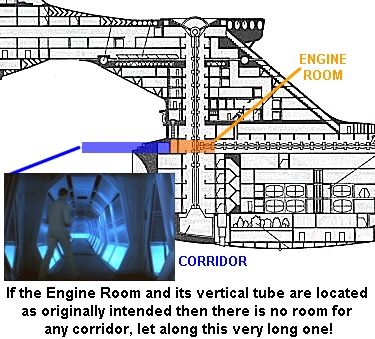
Nicholas Meyer only used the corridor painting once in TWOK, although again in a problematic location:
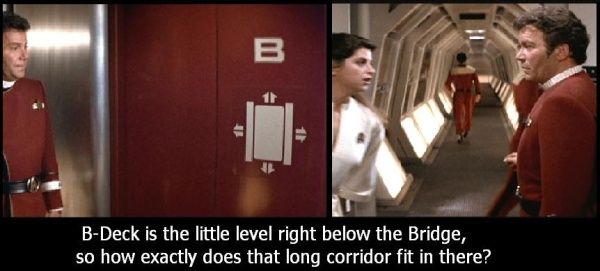
As such, I had an interesting thought:
The trouble with painted backdrops (in-universe) is that you don't need to be close up to see that it's an illusion - and although I initially suggested "holographic" images, I think I was being too generous, as the painted corridors hardly ever line up believably with the actual set. Painted backdrops share all the inherent problems of a forced-perspective set except that being 2-dimension the camera is even more restricted in the angles that work to carry the illusion. It is worst on a straight corridor, where the mismatching of lines becomes more obvious than ever, leading to floors that appear to slope up or down at weird angles. At worst, the painted backdrop depicts a corridor that diverts sharply to one side, when a moment ago it was straight.
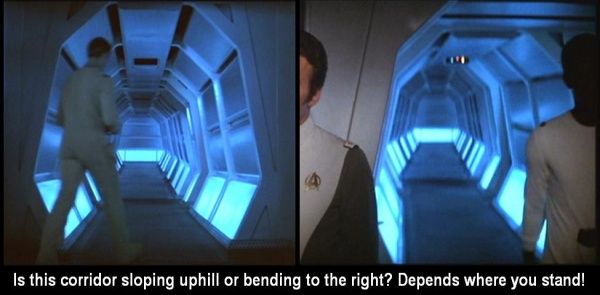
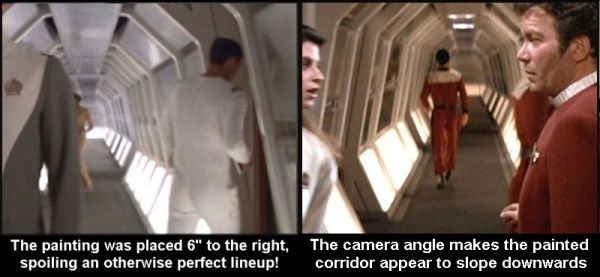
So where you can get away with it, backdrop paintings are a cheap solution to extending the depth of your set, far easier to build than a FP mockup. On the weekly grind of a TV series a one-off shot is far more likely to use a painting than a FP set - cost takes precedence even over drama!
TNG inherited the corridor backdrop painting from TMP, using it in the pilot but used paintings elsewhere too, such as in the episode Coming of Age. Here they used a backdrop used RIGHT NEXT to the actors, never a good thing!
Backdrops continued to be used throughout TNG, DS9 and VOY. Federation Jefferies Tubes were a frequent user from their very first appearance leading to some odd angles sometimes, although mostly worked OK if you squinted. In Lessons the "floor sloping" issue is present but the reasons behind the scene blocking are clear a moment later. It was used really well in Quality of Life but usually just wound up behind the actors, who would mask many of the limitations in using a backdrop painting.
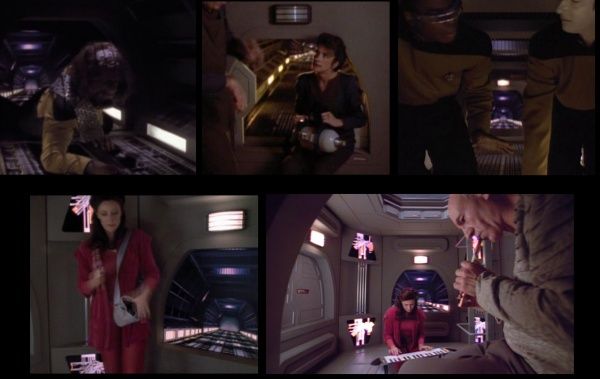
The best use of a painted backdrop in Star Trek was on the corridor set of DS9, where the effect was used to depict the huge curving arch of the massive space station. With no straight lines to match up, the illusion was far easier to carry off and the effect was used extensively throughout the show's run.
So, what can we make of all this in relation to the walls and corridors on the refit Enterprise? I must admit, I am half tempted to treat them as what they are - painted murals on the corridor walls, much as you'd find landscapes or pleasant vistas on modern hospital wards and posh reception areas. However, the image of a medium length straight corridor painted on a flat wall is neither aesthetically pleasing (like a landscape) nor would it carry off the illusion of extra space unless viewed from a very specific position. As we have seen, deviating from that viewpoint by even a little would make the corridor appear weirdly angled and thus fake - so why would any interior designer bother? In any case, the creative intent is clearly that they're supposed to be actual corridors on the ship, and I believe we should take them as such, taking the associated oddities as the inevitable technical gaffs they are. As for an in-universe explanation - maybe strange energy emissions from the new Warp Engines are causing visual distortions? The universe is a weird place, after all ;-)
FP has been used in film making for decades, in everything from The Time Tunnel to Willy Wonka. It was used in the Star Trek pilot "The Cage" of course (Talosian corridor), but more famously in the main series run as the "cathedral tubes" in TOS Engineering. Thanks to FP, in our first visit to the Engine Room we were treated to the depiction of a huge, long piece of equipment behind protective mesh and it looked pretty realistic.

Forced perspective sets are built with one end tapering from the other, to give the impression of distance. Being physical objects they pick up lighting the same as a normal set (or differently if required, as was often done with the Engine Room), and the actors can even interact with the set if they need to (a deleted scene in The Cage used children at the far end of the corridor). However, the illusion only really works from one or two different viewpoints, limiting the Director's creativity for blocking a shot. Before long the directors began freeing themselves from the restrictive camera angles that were imposed on them by FP and we ended up seeing the tube structure as it really was - drama always trumps realism in the industry.

FP was used agin for the Engine Room in TMP and works pretty well, with child-actors standing in for adults at the far end.

Only one camera angle was really used, which helped carry the illusion. The vertical isolation door in TWOK was added by Nicholas Meyer to block off the FP set and free up his camera angles However, in the process of filming the scene the tapered walls and walkway were revealed, along with the shortened sections of the intermix tube. Still, it is a great scene (again, drama takes precedence over technical inconsistencies).

As far as I know, painted backdrops were not used in TOS (although matte paintings certainly were). However, they too have a long history in stage & film and Robert Wise seemed perfectly happy to include them in TMP. As mentioned above, they were used as corridor extenders throughout the ship, even when it seemed impossible!

Nicholas Meyer only used the corridor painting once in TWOK, although again in a problematic location:

As such, I had an interesting thought:
Holographic panels suggesting more space than available might be an unorthodox but helpful solution, IMHO....the only way that such a long straight corridor could ever squeeze in...was if a portion of it was some sort of holographic display - perhaps an attempt by the Enterprise's interior decorators to relieve feelings of claustrophobia?
Helpful until you run into one by accident. Not a good way to trust your ship
How says these are high resolution? The closer one gets it could become more obvious it's just an illusion.
The trouble with painted backdrops (in-universe) is that you don't need to be close up to see that it's an illusion - and although I initially suggested "holographic" images, I think I was being too generous, as the painted corridors hardly ever line up believably with the actual set. Painted backdrops share all the inherent problems of a forced-perspective set except that being 2-dimension the camera is even more restricted in the angles that work to carry the illusion. It is worst on a straight corridor, where the mismatching of lines becomes more obvious than ever, leading to floors that appear to slope up or down at weird angles. At worst, the painted backdrop depicts a corridor that diverts sharply to one side, when a moment ago it was straight.


So where you can get away with it, backdrop paintings are a cheap solution to extending the depth of your set, far easier to build than a FP mockup. On the weekly grind of a TV series a one-off shot is far more likely to use a painting than a FP set - cost takes precedence even over drama!
TNG inherited the corridor backdrop painting from TMP, using it in the pilot but used paintings elsewhere too, such as in the episode Coming of Age. Here they used a backdrop used RIGHT NEXT to the actors, never a good thing!
Backdrops continued to be used throughout TNG, DS9 and VOY. Federation Jefferies Tubes were a frequent user from their very first appearance leading to some odd angles sometimes, although mostly worked OK if you squinted. In Lessons the "floor sloping" issue is present but the reasons behind the scene blocking are clear a moment later. It was used really well in Quality of Life but usually just wound up behind the actors, who would mask many of the limitations in using a backdrop painting.

The best use of a painted backdrop in Star Trek was on the corridor set of DS9, where the effect was used to depict the huge curving arch of the massive space station. With no straight lines to match up, the illusion was far easier to carry off and the effect was used extensively throughout the show's run.
So, what can we make of all this in relation to the walls and corridors on the refit Enterprise? I must admit, I am half tempted to treat them as what they are - painted murals on the corridor walls, much as you'd find landscapes or pleasant vistas on modern hospital wards and posh reception areas. However, the image of a medium length straight corridor painted on a flat wall is neither aesthetically pleasing (like a landscape) nor would it carry off the illusion of extra space unless viewed from a very specific position. As we have seen, deviating from that viewpoint by even a little would make the corridor appear weirdly angled and thus fake - so why would any interior designer bother? In any case, the creative intent is clearly that they're supposed to be actual corridors on the ship, and I believe we should take them as such, taking the associated oddities as the inevitable technical gaffs they are. As for an in-universe explanation - maybe strange energy emissions from the new Warp Engines are causing visual distortions? The universe is a weird place, after all ;-)
Last edited:

